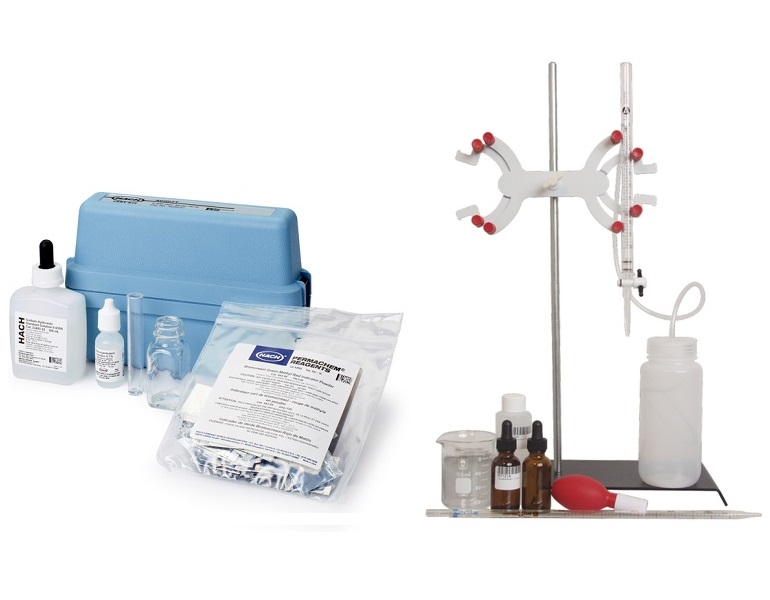Start 14-Day Trial Subscription
*No credit card required

How to Measure Sourness in Beer
We experience sourness in many ways. The puckering sourness of a lemon, that tart Greek yogurt, sour cream, sweet and sour chicken, hot and sour soup, Carolina barbecue sauce, acid rain and, of course, a good Flanders Red Ale, gueuze, gose, Berliner Weisse or fruit lambic. This article will discuss how to go about measuring sourness in a beer, and to help you determine how sour your beer actually is, both in its acidity and in its tasting profile.
Sour beers have been around for centuries. Many modern interpretations are done by “kettle souring,” which uses Lactic Acid Bacteria to sour the wort (pre-fermentation beer). This allows the wort to be boiled after souring and before fermentation, which protects the rest of the brewery from potential bacterial contamination. Kettle souring differs from traditional sour beer styles such as Flanders Beers from Belgium and Adam Bier from Germany, which achieve sourness while fermenting because of the bacteria that is on the equipment, in the buildings, in the air and on the “magic stirring stick” from previous batches.
Detected on our tongue from hydronium (H+) ions, sourness is one of nature’s warnings (along with bitterness – also popular in beer) that a food may be poisonous or dangerous. And yet we crave that acidity and bitterness. Hydronium ions are what makes things acidic: hydrogen chloride is hydrochloric acid, hydrogen acetate is acetic acid (as in vinegar), hydrogen sulfate is sulfuric acid and acid rain is produced from sulfurous acid (H2O water plus SO2 sulfur dioxide).

The pH scale and acid titration are two methods of measuring sourness in beer.
Apart from the faces we make when sampling increasingly sour beverages and foods, how does one measure the “sourness” of something? There are a couple of easy ways for the homebrewer (or beer connoisseur) to measure sourness. Measuring sourness via the pH scale (power of Hydrogen introduced by Carlsberg Laboratory in 1909) is done via a logarithmic scale from 0 (very acidic – Hydrochloric acid) to 14 (very alkaline – lye and drain cleaner) with 7 as neutral (pure water). In the wine and cider business, acid titration is used. Test kits for both methods are available at your local homebrew store (LHBS).
pH can be measured with Litmus and pH paper strips. Litmus paper turns red with an acidic solution, blue with a basic (alkaline) solution, and does so in various shades that can be compared against a chart of colors. Greater accuracy can be obtained using pH paper strips with specific ranges (I use a 4.6-6.2 strip and a 2.8-4.4 strip) based on some dyes and chemicals that change color in different pH ranges.
However, pH papers are difficult to read accurately. For better pH accuracy, you can buy an inexpensive ($50) pH meter from your LHBS that gives you accuracy to 0.1 pH – but it needs to be calibrated and well cared for. The actual pH drops as temperature increases, so measure the pH of your beer at serving temperature: A beer that is pH 4.0 at 5°C (41°F) will have a pH of 3.955 at 10°C (50°F) and a pH of 3.91 at 15°C (59°F), so there can be a tasting impact (10^-4 = 0.0001; 10^-3.91=0.000123, indicating a 23% increase in acidity). Since pH is a logarithmic scale, each decrease in number represents ten times the acidity, so pH 3 is ten times (1000%) more acidity than pH 4.
Acid titration kits (from your LHBS) are very useful to the homebrewer. The basic idea of titration is to use some indicator dye that changes color based on acidity, add a few drops to your test solution (beer, wine, etc.) then very slowly add a concentrated test solution, repeating until the indicator dye shows a color change. Dark test solutions can be diluted by adding twice the volume of distilled water. Remember that phenolphthalein (LINK) that you played with in high school chemistry? It is bright reddish pink in alkaline solutions, clear in acidic solutions. The “Winemakers Acid Test Kit” that I have uses phenolphthalein to measure the percent acidity tartaric of grape wine. European winemakers measure their products at ppt (parts per thousand, or grams per liter) sulfuric.
There are several types of acid that will affect your beer. Sometimes they are appropriate for the style of beer; sometimes they are a flaw that produces undesired flavors and aromas.
- Acetic Acid is what makes vinegar what it is. Vinegar is made from apple cider or from wine, intentionally “soured” by Acetobacter. Acetobacter is an aerobic bacterium that needs oxygen to thrive, so beers and wines that have been exposed to air or oxygen are more likely to go sour. Acetic acid is inappropriate in all styles of beer except Flanders Red, where small amounts help to give the beer its trademark complexity and wine-like character.
- Citric Acid comes from citrus fruits. The flavor we most associate with citric acid is lemon. Although citric acid is produced during fermentation of beer, helping to increase the acidity, it is produced in small amounts so that the flavor is not typically noticed, other than possibly in a Belgian Witbier or in a Fruit Beer made with citrus fruit. Citric acid is more often found in Pear Cider (Perry).
- Carbonic Acid (H2CO3) is a weak acid that occurs when CO2 (carbon dioxide) under pressure is dissolved in H2O (water). Carbonic acid adds a bit of a bite or tang to your beer tasting experience and with higher levels of CO2 (such as in a Hefeweizen or Champagne), adds a prickly mouthfeel.
- Lactic Acid is the most common souring agent in beer. It has a clean sourness without contributing additional flavors. Depending on the amount produced (or added) when the beer was made, the sourness can range from a light tartness (as in a Gose), to a clean sharp tartness (in a well-made Berliner Weisse), to a mouth-puckering sourness that is a major component of the beer style (Lambic, Gueuze). Lactic acid is generally produced by Lactic Acid Bacteria (LAB), including Lactobacillus and Pediococcus.
- Malic Acid is important in Apple Cider and Perry. This is the acidity that produces the tartness in apples. Malic acid is a relatively harsh acid for flavor, so Cider and Perry is often blended to reduce high acidity. In addition, the Oenococcus bacteria can be used in Ciders (particularly English and French) to convert some of the Malic acid to Lactic acid, in a process called Malolactic Fermentation (MLF).
- Phosphoric Acid is relatively flavorless and is often used to adjust the pH of the water while making a beer. Getting the pH in the right range helps the enzymes for mashing the grain (to convert the starches to sugars and extract the sugars) to work most efficiently.
- Tartaric Acid, the standard reference for Acid Titration, comes from grapes, and typically has little effect in beers except fruit beer made with grapes. Tartaric acid is also a consideration when making a Pyment (Grape Mead).
- Fatty Acids have more of a flavor impact. Brettanomyces (Greek for “British fungus,” identified at Carlsberg Brewery in 1904 while researching the cause of British beers souring) also can contribute a small amount of Acetic acidity, but Brett’s contributions to beer generally are various phenolic and earthy tastes/aromas: Bacon-like, wet horse, leathery, barnyard, smoky, cheesy, fruity, pineapple notes, and others, many of which are associated with fatty acids like Capric Acid, Caproic Acid, or Isovaleric Acid. The famous Orval Trappist Ale is dosed with Brett when it is bottled: The Brett contributes to Orval’s interesting complexity. Orval bottles are vintage dated – I recommend to open bottles that are at least 2 years old: age continues to improve the beer.
Enough with the scientific stuff – how does sourness and acidity affect how you taste beer? You may have had various IPAs or Pale Ales that are either fresh and crisp or are somewhat muddled in flavor. Sometimes it’s the recipe, but often it’s the acidity. A lower pH in an IPA or Pale Ale (but not low enough to detect as “sour”) brightens up the hops and produces a fresher tasting product that “pops.” What do you do if the beer is too sour? One of the solutions for Berliner Weisse drinkers in Germany is to add a dash of a sweet syrup (Woodruff and raspberry are common) to balance the acidity.

Back to the original question: How sour is that sour beer? Even with all the scientific measurements, the final test is your palate. (Photo Courtesy Flickr/scottb211)
Another advantage of lower pH beer is that even if it spoils, the low pH keeps the food poisoning bacteria (like Staphylococcus) at bay: Staph survives down to about pH 5.0, but typical ales and lagers are in the 4.0-4.7 pH range, with sour beers dropping to a pH of around 3.0. Meads and ciders use acidity as one of their points of complexity for a balanced product (along with tannins, alcohol, sweetness, and flavor), and improves their shelf life by keeping the pH relatively low to prevent unwanted infection.
Back to the original question: How sour is that sour beer? Even with all the scientific measurements, the final test is your palate. Since other factors (such as sweetness or temperature) may balance the sourness, the actual perceived sourness may vary greatly from the measured pH or Titratable Acidity, and from person to person. The best solution is to try a lot of different beer styles to see what styles you like. Styles may offer a wide latitude for interpretation, but that’s part of the fun of trying beers that you haven’t had before. Organize a tasting party with several sour beers (either a vertical of all one style, or a horizontal one of each style) to compare and contrast the acidity levels. If you want to truly geek out, bring your Litmus paper or pH meter – the differences from measured sourness to tasted sourness can be quite dramatic! Cheers!
Header Photo Courtesy Flickr/Bernt Rostad



